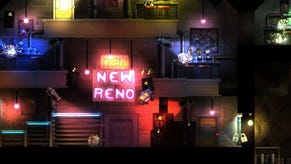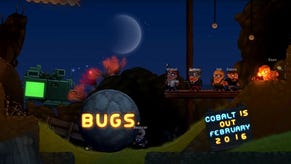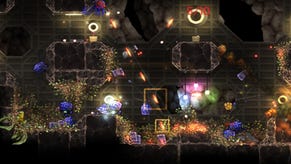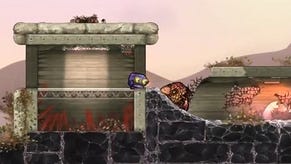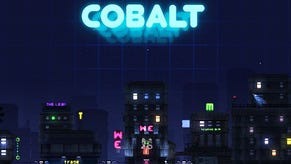Wot I Think: Cobalt
A 2D shooter with style.
Cobalt is about a tiny, blue, quick-witted murderbot who’s travelling through space with its ship’s AI, searching for remnants of human life. It’s a story that tackles themes like consciousness and sentience, but it’s tongue-in-cheek and full of lighthearted touches - like stumbling across a copy of Do Androids Dream of Electric Sheep in a library, or meeting an enclave of dubstep-listening, friendly robots who identify as non-binary genders. It’s SOMA via Futurama and Max Payne, and here’s wot I think.
From the outside Cobalt appears to be simple 2D, physics-based shooter, but if you jam a crowbar under its metallic blue plating and tear it back to reveal the tangled circuitry beneath, you might be surprised by its composition. Under its surface there’s a complexity to Cobalt’s systems and a surprising depth that will keep you playing.
Combat is made up of three disciplines: melee, firearms and thrown, with different weapons available for each. You can switch between these at any time and use a mix of the three to kick sufficient arse. Other than that, you get a jump, a kick - which is for double jumping as well as for kicking that aforementioned arse - and a roll. It’s a game that requires timing, precision and aggression. At times it feels like a character action game.
Let me explain. When an enemy fires a potentially fatal shot towards you, time slows for a couple of seconds, signalling the window in which you can perform Cobalt’s version of a parry. Though the game does allow you to hang back, and there are other legitimate ways to approach combat (more on which later), this is a game that encourages aggression. Using Cobalt’s roll at the right time to send your little blue bot careening into a projectile will deflect that bullet back at your attacker. This is a shooter where you launch yourself into incoming bullets. It’s as refreshing as it sounds.
Likewise, when an explosive flies towards you - be it a rocket or a grenade - you can use a melee attack to bat it back at your aggressor. It’s an interesting twist, and one that takes some adjusting to, but it feels rewarding once you wrap your head around it. Spamming the roll results in your gymnastics slowing down, upping the chance you’ll be shot in the feet - your only vulnerable area during the maneuver - meaning you have to react rather than guess. You can even shoot while rolling, but you have to time your shots with the roll to make sure they aren’t aimed at the floor - although punching the floor during a roll can give you a bit of extra height on a jump.
Discovering new uses for your abilities is one of the most satisfying things about Cobalt. Take the roll for an example: as well as the things I’ve already covered, rolling into a jump gives you more forward trajectory; where jumping into a roll sees you spinning through the air, bouncing off any wall you come into contact with like a heavily-armed pinball. The first time I jump-rolled over an enemy and timed a punch to smash their metallic head into bits, I screamed “yassssss”. I even unlocked a new character for Arcade mode for being such a cool guy.
One of my favourite things to do in Cobalt is to jump onto a slope and crouch as I land, sending me into a John Woo-style slide - minus the doves - dismembering enemies with my bullets on the way down. Its shooting is designed to be playable with a keyboard or a controller (I used the latter) so aiming is handled automatically, your laser pointer hovering over the nearest hostile as long as you crouch or point up, which makes sliding assaults child’s play. It all feeds back into encouraging a near constant forward momentum.
You can exploit this movement to speed through the screens and avoid enemies in some areas, but then you’ll miss out on all of the equipment they drop, putting you at a disadvantage later on when the difficulty ramps up considerably. This isn’t an easy game, and death is a sudden and recurring interruption. There were definitely a few sections that made me want to do an aerial roll and punch my PC into tiny pieces, but it’s all worth it for the elation you feel upon conquering a tough encounter.
More often than not, you just need to change your tactics. Some of Cobalt’s levels fold back on themselves, offering optional areas and multiple routes. Sometimes an area’s geometry can allow you to come in from an unexpected angle, getting the drop on the bewildered enemies below with a well-placed explosive - though you’ll need a bit of luck with these, as they’re prone to landing where they want. Some of these opportunities are level specific: powering down security systems, pushing a minecart onto an enemy’s noggin, or using friendly NPC to act as handy meat shields.
You can use a thrown item to spawn an allied animal to help with combat, too, or even to ride into battle. And in a lovely touch, the game randomly assigns them a name after a set time. At one point, I spent about 15 minutes with a furry, overgrown hamster called Thelma. It destroyed me when she died, my robot avatar signing her off by name and telling her she’ll be missed. I’ll never forget you, Thelma.
It’s not just these spawned creatures, though. As you might have gleaned from my earlier mention of the sentient robot enclave, Cobalt has friendly NPCs that you can chat to, attack, steal from, or even get them to help you out when a rival faction breaks screen boundary conventions and follows you into the next area. There’s a simple conversation system in place, though the options are generally limited to getting more information on the world, or telling them to shut their stupid mouths.
It feels like I can keep talking about new features all day. When infiltrating an enemy compound you can go in all guns blazing, use stealth - which admittedly can be a touch fiddly - or a mixture of the two. There are terminals to be hacked, locks to be picked, hostages to be rescued, resourced to be mined, safes to be cracked, and more. For brief moments, it can feel like a 2D Deus Ex. It is rich with ideas.
On top of all these systems, it’s the physicality of the world that anchors you, creating moments that feel exclusive to you. At one point I rescued a little mushroom fella called George, and he gave me a bunch of rewards for doing so. I assumed that was it, so I started getting on my way. Suddenly, I realised I was being followed - it was George. I lowered the elevator I was riding, crushing him beneath it as I leveled with his floor. “Farewell George,” said my sociopathic blue robot as my heart again broke into a thousand tiny pieces.
It’s a likeable game, and it feels fantastic to play when you nail an extended combat encounter with a chain of flawless shots, deflections, rolls, slides and aerial skull punches. It can be a touch imprecise, especially when trying to time a shot while rolling or throwing an explosive, but sometimes your failures can be just as entertaining as an unbroken display of acrobatic death.
At other times though, Cobalt feels like it’s trying a little too hard to be funny. While its writing might raise a smile, it’s rare that it elicits much more of a response than that. The splash screen when you die is a perfect example of this, flashing up variations of “you died”. When you encounter one of the game’s monstrous difficulty spikes and you’re greeted with things like “you dies”, “you super dead”, or “you diedest”, it gets irritating quickly.
But even with that meagre caveat, I’d still recommend Cobalt based solely on its story mode. Doubly so given that you can play through the mode with a friend, potentially changing the dynamics of each encounter. It’s also accompanied by multiplayer deathmatch, survival modes, a variation of capture the flag, and more, all of which benefit from the same satisfying combat system. And even without all these extras, any game that lets you ride a giant hamster-thing called Thelma deserves a punt.
Cobalt is released on February 2nd for Windows via Steam.






